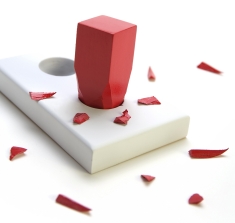Cristal® Clear

Such is the disclaimer on the new Jaume Serra Cristallino Cava label. Jaume Serra lost a four year court battle late last year where Roederer claimed Cristallino was infringing on their trademark and damaging the reputation of their Cristal® brand.
It’s too bad that Jaume Serra did not file their suit first as I think they have a valid case. Clearly Cristal® does more to damage Cristallino’s reputation than the other way around.
First take Louis Roederer Cristal® , a hideously overpriced, famously bad value preferred by drug dealers, new money and basically anyone who has more money than sense. There are few better examples of a wine that tags you as a wine know-nothing than drinking Cristal® . OK, admittedly Dom Perignon is worse. One thing for sure, when you see someone drinking Cristal® in a restaurant you can be assured they know nothing about Champagne. The pretentious and vacuous Cristal® shares its pleasures mostly with people that could care less about what they’re drinking as long as the name is right.
Then you take Jaume Serra Cristallino Cava, a delightful and refreshing wine that brings lovely bubbly pleasure at an incredible price for a truly pleasant and well made wine. Repeatedly listed in the major wine publications as an excellent value, Cristallino is front and center at many joyous events like weddings, birthdays, anniversaries and divorces. Cristallino brings and shares joy with the masses, otherwise known as us.
Cristal® and Cristallino do have one thing in common: they are both industrial mass-produced wines.
Is Cristal® a better more complex wine than Cristallino? Without a doubt, but who cares. What you give up intellectually and emotionally in buying Cristal® is not worth it. Selling your soul to the devil always has its price.
In my opinion it should have been Cristallino suing Cristal® for defamation of character as being associated with the preferred bubbly of drug dealers and superficial pop stars is an insult to a pretty little wine that brings daily smiles to so many at the end of a hard day and that can turn any evening into a celebration.
In seeking the best of the best, those with more money than is good for them are drawn like bugs to a nightlight by brand names promising exclusivity. However, when it comes to Champagne, the big name brands are mass produced products like the perfume and luggage also made by the companies that own them. Think about it. Dom Perignon and Cristal® are sold at every luxury hotel, restaurant and retail store in the entire world. Heck, if you’re in the right neighborhood you can find them at the 7-11. Fake exclusivity is easy to sell to those hungry for exclusivity for its own sake.
Smart wine drinkers avoid such Champagnes and drink the wonderful estate (grower) Champagnes widely available throughout the United States or the excellent super-premium sparking wines now produced around the world, including the excellent Roederer made in California’s Anderson Valley. In between they toss in bottles of Cristallino for fun on Wednesday nights and for big parties. Without a doubt, there would be a lot less joy in the world without Cristallino, but no one would suffer from the loss of Cristal® .
In our refrigerator there is always a bottle of Cava (usually Cristallino) or two and a couple of grower Champagnes. Excellent grower Champagne is easy to find and you don’t even have to know the estate. Just look for those imported by Rebecca Wasserman, Neal Rosenthal, Kermit Lynch and Terry Thiese. However, Cava still stands as the best value in the world of sparking wine. That’s a fact that’s Cristal® clear.
















 The 2008 Vietti Tre Vigne is here! The Vietti Dolcetto Tre Vigne Dolcetto d’Alba is always on my every day favorite list. Explosively fruity, brisk, zesty and bright. It’s all about immediate pleasure - no waiting required. That’s why I’m always excited when the new vintage arrives as it’s never more fun to drink as when it’s a charming adolescent and, anyway, it’s a boring adult so waiting is not recommended. Maturity is for nebbiolo not dolcetto. In fact I’m already anxiously waiting for the 2009.
The 2008 Vietti Tre Vigne is here! The Vietti Dolcetto Tre Vigne Dolcetto d’Alba is always on my every day favorite list. Explosively fruity, brisk, zesty and bright. It’s all about immediate pleasure - no waiting required. That’s why I’m always excited when the new vintage arrives as it’s never more fun to drink as when it’s a charming adolescent and, anyway, it’s a boring adult so waiting is not recommended. Maturity is for nebbiolo not dolcetto. In fact I’m already anxiously waiting for the 2009.